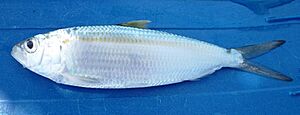Madeiran sardinella facts for kids
Quick facts for kids Madeiran sardinella |
|
|---|---|
 |
|
| Conservation status | |
| Scientific classification |
The Madeiran sardinella (Sardinella maderensis) is a small, shiny fish. It belongs to a group of fish called ray-finned fish. You can find this fish in the eastern Atlantic Ocean and the southeastern Mediterranean Sea.
This sardinella looks a lot like the round sardinella (Sardinella aurita). But you can tell them apart by their tail fins. The Madeiran sardinella has gray tail fins with black tips. These fish eat tiny plants called phytoplankton and also young fish. They live near the surface of the ocean in coastal areas. They often swim together in large groups, called schools, sometimes with round sardinellas. Sadly, the International Union for Conservation of Nature says this fish is "vulnerable". This means its population is at risk.
Contents
Spotting a Madeiran Sardinella
It can be tricky to tell the Madeiran sardinella apart from other sardinella types. This fish has a long body and sometimes a slightly bulging belly. The top rays of its pectoral fins are white on the outside. The skin between these rays is black.
Key Differences
It is very hard to tell the Madeiran sardinella from the round sardinella. But here are some clues:
- The Madeiran sardinella has only seven rays on its pelvic fins.
- It does not have a black spot on the back of its gill cover.
- Its tail fin is gray with black tips.
Where Madeiran Sardinella Live
Madeiran sardinellas spend most of their lives near the water's surface. They can also swim into estuaries and lagoons. This is because they can handle water with very low salt levels.
What They Eat
These fish mostly eat tiny ocean plants called phytoplankton. They also feed on the very young stages of other fish, known as fish larvae. Madeiran sardinellas are among the larger fish in their group. They can grow up to 35 centimeters (about 14 inches) long.
Why Madeiran Sardinella Are Vulnerable
The number of Madeiran sardinella in the ocean has been going down. Fishing boats used to catch more of them. For example, in 2003, they caught 1.8 tonnes per trip. But in the next two years, this dropped to 1.5 tonnes.
Fishing and Fish Size
The main places where these fish are caught are off the coasts of Senegal and Morocco. Over the last ten years, the average size of the fish caught has also gotten smaller. It went from 35 cm down to 32 cm. Experts believe that a lot of this change is due to heavy commercial fishing in the area. Both the Madeiran sardinella and the round sardinella are being caught too much. This is why the International Union for Conservation of Nature has listed the Madeiran sardinella as a "vulnerable" animal.


